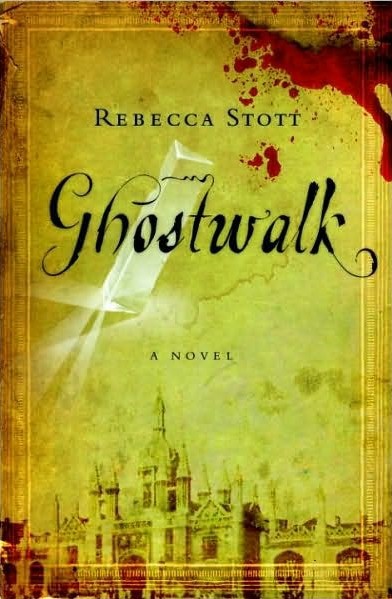A Palimpsest of Time

Ghostwalk by Rebecca Stott (Spiegel & Grau, 2007)
Reviewed by Cindi Di Marzo
Author Rebecca Stott is preoccupied by the ever-shifting boundaries of time and elusive nature of scientific concepts. Above these concerns in her spellbinding literary creations lingers obsession, the all-consuming desires that drive men and women to achieve great things and enter doomed love affairs.
In her biography of Charles Darwin (1809-1882), Darwin and the Barnacle (2003), for example, Stott narrowed her vision on an early but critical force behind Darwin’s theory of evolution, his obsession with a particular form of crustacean. As Publishers Weekly said in a review of the book, “If he had died in 1854, [Darwin] would have been remembered as the author of a groundbreaking four-volume study of all the different shapes and sexual variants that these crustaceans exhibit.” And in Stott’s latest novel, The Coral Thief, set in the summer of 1815 just after Napoleon’s defeat at Waterloo, a young Scottish anatomy student studying in Paris is drawn into a series of thefts centered on an obsession with a highly sought-after fossil-like marine organism.
In Ghostwalk, Stott adds the scientific theory of entanglement to a heady concotion of mystery, murder, intrigue and passion. Seemingly, the master magician behind the unsettling events in which writer Lydia Brooke becomes entangled is English mathematician and natural philosopher Isaac Newton (1642-1747). Most of Newton’s biographers have focused on his major scientific discoveries: the law of universal gravitation, the full-color composition of white light, and the principles leading to modern calculus. Newton studied at Cambridge University in England in the 17th century, was elected fellow of Trinity College in 1667 and then appointed Lucasian Professor of Mathematics in 1669. Stott’s vision of 17th-century Cambridge during Newton’s years there coinciding with the English Plague (1665-1665) provides a robust context for her page-turner. Without a doubt, Ghostwalk qualifies as a bona fide mass-market hit.
Stott’s tale begins when Brooke travels from Brighton to Cambridge to attend a funeral. Cambridge University scholar Elizabeth Vogelsang, the mother of Brooke’s former lover, has died just as she was concluding her controversial biography of Newton. When Brooke lived in Cambridge, she noted Vogelsang’s ability to inhabit a subject. In fact, Vogelsang seemed to live in the 17th century. Asked by Vogelsang’s son, Cambridge neuroscientist Cameron Brown, to complete his mother’s work, Brooke reluctantly agrees. So begins a series of incidents that Brooke hopes are coincidences, figments of her imagination and mere dreams. Eventually, Brooke comes to believe with Vogelsang that time is a palimpsest, a fluid layering of people, places and events fueled by a force known in modern science as “entanglement.” A term used in quantum theory, entanglement predicts the manner in which particles of energy and matter will continue to interact even after separation.
Brown’s request ignites their still-simmering romance, forcing Brooke to consider, at last, his Machiavellian effect on her. Currently leading a team at Cambridge developing a new drug, he tells her, to treat depression, Brown weaves through Brooke’s life. He makes nocturnal visits to her at his mother’s studio where she is completing Vogelsang’s manuscript; sends text messages to her computer; and leaves voice messages on her phone. Together or apart, they cannot act without the other being impacted. Frightened by strange light effects in Vogelsang’s studio and Brown’s control over her, Brooke resists his possible role in an international conspiracy masked as a war between animal-rights activists and enlightened scientists.
In an author’s note, Stott explains her method of bridging historical fact and fictional narratives to fill historical black holes. Like Vogelsang, a fictional character who employs supernatural means to probe deeper, Stott has wrestled with facts and toyed with scenarios. Yet a true story, Stott knows, is not always the most plausible one. Newton’s biographers have avoided the curious murders of Trinity fellows and prominent alchemists that bookend Newton’s appointment as professor. But Stott suggests that Newton’s obsession with alchemy is as inextricably entangled with his scientific discoveries as are the 17th and 21st centuries; the deaths of Trinity scholars and animals used for scientific inquiry; completion of Vogelsang’s magnum opus and her fall down a staircase that no longer exists; and the helix-like spiral of Brooke’s and Brown’s fates.
A professor of English literature and creative writing at the University of East Anglia in Norwich, Stott is a gifted writer. She plays with multiple meanings, using words and their varying connotations as investigative tools. For example, when Brown sends a message to Brooke, stating that she seems to be hanging in the air in which he walks, she considers if she is hanging, “like a spider on a single thread of its own making or like a woman hanged for a crime or like a torture victim or a slab of curing meat or, or, like mist rising from a river…? Hanging. Hanging on. Hanging in. Hanging fire. Hanging up.” Similarly, Stott practices verbal alchemy as Brooke ponders multiple implications of such words as lie, embroil and entangle.
Period illustrations and maps, a list of “sins” recorded by Newton in code in 1662 (decoded in 1963 by Newton biographer Richard Westfall), and recipes from one of Newton’s notebooks for mixing colors and curing sickness, amplify Stott’s persuasive portrait of Newton and his Cambridge. Fearless in pursuit of answers to his burning questions, Newton explored optics by using an instrument to probe his eye socket, nearly blinding himself by staring too much at the sun. He considered alchemy a powerful means to answer scientific questions of great consequence. While they might not feel the same impetus toward science, surely readers will recognize the alchemy involved in intimate relationships. A layering of desires so entangled one cannot tell where one ends and another begins, Ghostwalk is a rare treat, a book with the power to enlighten as it entertains.
 
 












